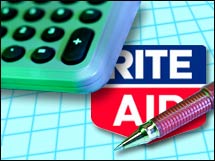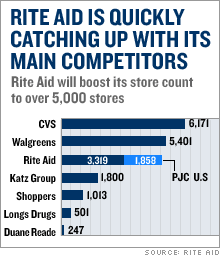|
Rite Aid makes move for Eckerd, Brooks No. 3 drugstore chain announces cash, stock and debt deal worth $3.4 billion to bring total stores to about 5,000. NEW YORK (CNNMoney.com) -- Rite Aid Corp., the nation's No. 3 drugstore chain, announced a deal Thursday worth about $3.4 billion to buy the Eckerd and Brooks drugstore chains from their Canadian parent, the Jean Coutu Group. The deal will include $1.45 billion in cash as well as 250 million shares of Rite Aid (Charts), which will make the Jean Coutu Group the largest shareholder of the new company with about a 32 percent stake.
The stock was worth $1.17 billion at Wednesday's closing price. Rite Aid is also assuming $850 million of Jean Coutu's debt. The move will give Rite Aid 5,000 U.S. stores, with locations both on the East and West coasts. It will also give Rite Aid scale comparable to its major competitors. Rite Aid currently trails No. 1 Walgreens (Charts) and No. 2 CVS (Charts). CVS has 6,100 U.S. stores, while Walgreens has 5,400 stores but larger sales. Rite Aid said that, even with the large use of its stock in the purchase, the transaction should add to earnings per share within 12 months. The company will drop the Eckerd and Brooks brands and use the Rite Aid name on all the stores being purchased. The deal is part of a continuing consolidation within the nation's drugstore sector and follows the purchase of 700 drugstores by CVS from grocer Albertson's earlier this year. The Eckerd chain once belonged to retailer JC Penney (Charts), which in April 2004 split the operation and sold it to CVS and Jean Coutu Group, already the owner of the Brooks Pharmacy chain. Jean Coutu paid $2.375 billion for 1,540 of the Eckerd stores at that time, while CVS paid $2.15 billion at that time for 1,260 of the stores. Richard Hastings, senior retail sector analyst with Bernard Sands, said the Eckerd acquisition was challenging for Jean Coutu from the start. "Jean Coutu gobbled up more than they could digest," Hastings remarked. "There were significant issues with the Eckerd integration. Jean Coutu underestimated the issues facing Eckerd's non-pharmacy business and its regional competitive threats. I'm not surprised they decided to sell it off." For Rite Aid, the most important aspect of the deal is that it gives the retailer the ability to expand its footprint nationally while becoming more cost-efficient, said Marshal Cohen, chief retail industry analyst with NPD Group. "People are much more mobile today, with the average person moving every seven years. So it's really advantageous for a retailer to be more national than regional," Cohen said. In a conference call with analysts, Rite Aid CEO Mary Sammons said the deal would enable the company to "compete effectively in a very competitive business." About 70 percent of the Eckerd and Brooks stores are located in 14 states where Rite Aid already does business. Additionally, the company will now have acquired locations in Massachusetts, Rhode Island, South Carolina and North Carolina, she said. Some analysts estimate that Rite Aid's expansion through its Eckerd/Brooks deal could create a "significant overlap" with its existing stores in some markets, thereby raising antitrust issues. Sammons said in the call that she would not speculate on the matter but added that the company would go through a regulatory review process. Cohen expects Rite Aid's competitors CVS and Walgreens will respond to its move by ramping up their own expansion plans. "There's no question that this will happen. It's like a game of chess," said Cohen. "The top drugstore chains are all trying to go national. So if one company becomes dominant in one region, it really affects the other. They each want to put the other in check." At the same time, the drugstore sector itself is undergoing rapid evolution. "Drugstores are becoming more like convenien[ce] stores," said Cohen. "The frequency of store visits has increased as Americans resort to buying more over-the-counter products." Drug stores are also selling a greater variety of products like milk, electronics, toys and even some high-end beauty products. "It's not unlike going to a gas station and picking up chips and other consumables," he said. "Drugstores are the next growth area in big-box retailing. But the challenge to these companies is determining how much merchandise they can fit into their stores," Cohen said. "These stores are typically smaller than grocery stores, but don't be surprised to see drug store operators start to build bigger formats in the future." Rite Aid said the deal is expected to close in the fourth quarter of its current fiscal year. The company also maintained its current fiscal full-year guidance. Rite Aid expects sales to be between $17.4 and $17.6 billion. Its net income or loss guidance range is between loss of 7 cents a share and a profit of 2 cents a share. Sales at Rite Aid stores open at least a year - a key retail measure known as same-store sales - are expected to increase 2 to 4 percent for the year. Analysts, on average, expect Rite Aid to post sales of $17.4 billion for the year and earnings per share to be flat versus the previous year, according to First Call. |
|


